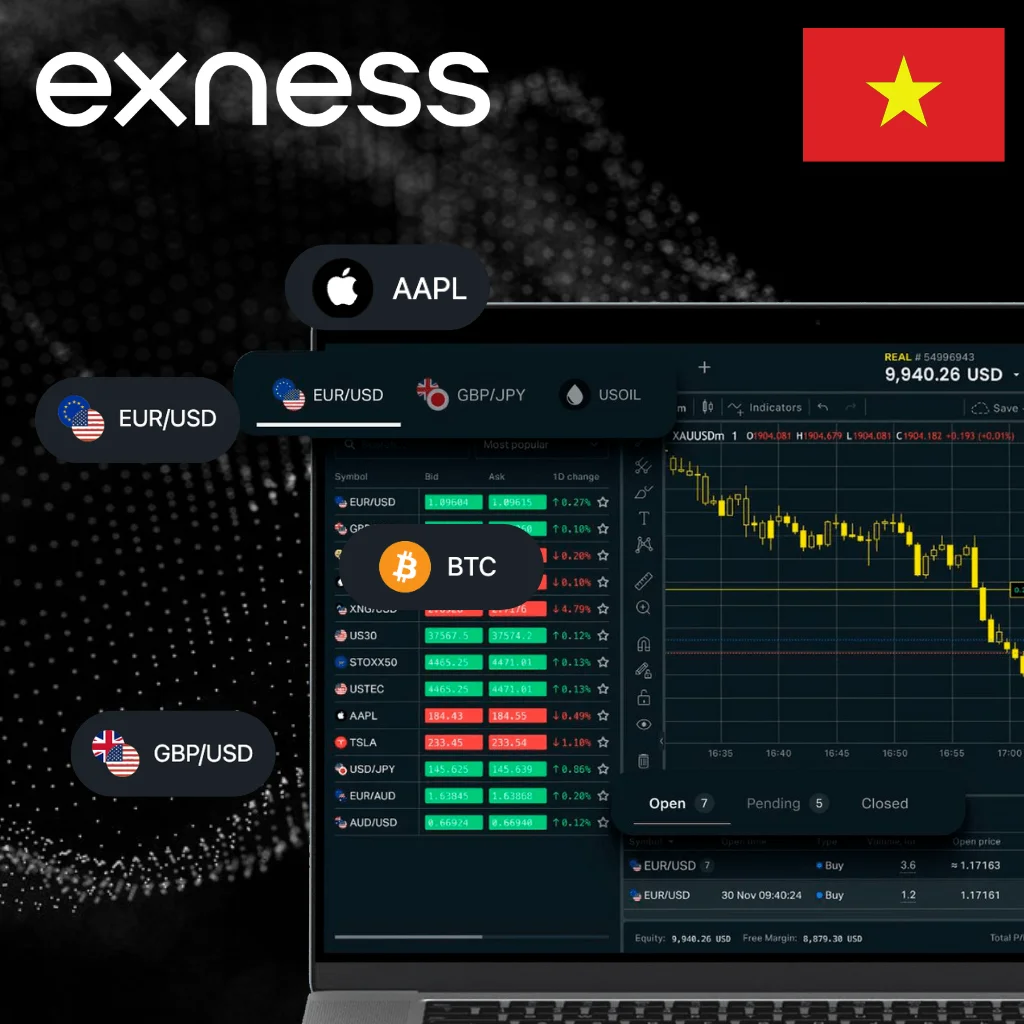- What is Exness Leverage and How It Works
- Exness Leverage Levels on Different Account Types
- Maximum Exness Leverage
- Advantages and Risks of Using High Leverage
- Risk Management Strategies When Using Leverage
- Margin Call Exness
- Exness Stop Levels
- Choosing the Right Leverage Level on Exness
- How to Change Leverage on Exness
- Frequently Asked Questions (FAQs) About Exness Leverage

What is Exness Leverage and How It Works
Leverage in trading is a mechanism that allows you to control a trade size much larger than the actual capital in your account, and it can first be tested safely through an Exness demo account.
Example: With leverage of 1:100, by depositing just 100 USD, an investor can open a position worth 10,000 USD.
How it works:
- The trader deposits a small margin.
- The broker provides the remaining amount as temporary credit.
- Profit/loss is calculated based on the full order value, not just the margin.
Illustrative table of order size calculation by leverage:
| Actual Capital (USD) | Leverage | Controlled Volume (USD) |
|---|---|---|
| 100 | 1:50 | 5,000 |
| 100 | 1:100 | 10,000 |
| 100 | 1:500 | 50,000 |
| 100 | 1:2000 | 200,000 |
Exness Leverage Levels on Different Account Types
Exness designs multiple account types with different leverage limits, suitable for each trading strategy and risk appetite.
- Standard Account: Flexible leverage, with potential access to extremely high levels.
- Standard Cent: Designed for beginners, still offering high leverage but requiring smaller margins.
- Pro Account: Intended for professional traders, supporting many leverage options.
- Raw Spread and Zero Accounts: Usually for large-volume trading, combining low spreads with high leverage.
Basic comparison table:
| Account Type | Maximum Leverage | Key Features |
|---|---|---|
| Standard | Up to unlimited | Flexible, suitable for various strategies |
| Standard Cent | Up to unlimited | Small capital, safer testing |
| Pro | Up to unlimited | Suitable for large-volume trading |
| Raw Spread / Zero | Up to unlimited | Ultra-low spreads, focused on scalping |
Maximum Exness Leverage
One of the standout features of Exness is its ability to provide unlimited leverage for many account types. However, in order to unlock this level, the account must meet certain requirements regarding capital and the number of executed trades, and these conditions can also be managed directly via the Exness web terminal.
In the initial stage, new accounts usually have a temporary leverage limit, for example 1:2000 or lower. Once the system conditions are met, the unlimited leverage option will be activated.
Basic conditions to use maximum leverage:
- Full account verification.
- Deposit the required minimum capital.
- Execute a certain number of trades.
Advantages and Risks of Using High Leverage
High leverage is always a double-edged sword in trading. Investors may increase profits quickly but also face the risk of losing capital just as fast, which is why many start cautiously with the Exness minimum deposit.
Advantages:
- Control large positions with only a small amount of capital.
- Increases flexibility for short-term trading strategies.
- Opportunity to multiply profits quickly in highly volatile markets.
Risks:
- Losses can exceed expectations, especially without Stop Loss.
- Emotional pressure may lead to account wipeout.
- Poor capital management can quickly result in trading failure.
Short list of safe principles when using Exness leverage:
- Never use all capital as margin for a single order.
- Always set Stop Loss.
- Maintain discipline and avoid doubling trades to recover losses.
- Assess the risk/reward ratio before opening a position.
Risk Management Strategies When Using Leverage
Risk management is the key factor in maintaining account sustainability. Some commonly applied strategies include:
- Fixed capital allocation: Risk only 1–2% of total capital per trade.
- Flexible Stop Loss placement: Set Stop Loss based on average volatility (ATR) instead of intuition.
- Trade scaling: Instead of one large order, open multiple smaller ones to spread risk.
- News monitoring: Avoid using high leverage when major market news is expected.
Margin Call Exness
When margin levels fall below the set threshold, the system triggers a Margin Call to warn the trader.
- The common Margin Call level at Exness is around 60%. If usable margin falls below this level, the system issues a warning.
- If losses continue and margin drops to a lower threshold (e.g., 0% or 30%, depending on account type), the system automatically closes positions.
This mechanism prevents losses from exceeding the actual account balance, which is particularly important to understand alongside factors such as Exness trading hours.
Important notes:
- Always check margin ratio before opening new trades.
- Avoid having too many open positions beyond account capacity.
- Use leverage wisely to prevent unexpected Margin Calls.

Exness Stop Levels
Stop Level is the minimum distance between the market price and a pending order.
Example: If the Stop Level is 2 pips, you cannot place a pending order closer than 2 pips from the current market price.
This directly affects scalping strategies, where traders often want to enter orders very close to the market price, a factor also considered by partners promoting the Exness affiliate program.
Factors affecting Stop Level:
- Account type (Standard, Pro, Raw Spread, Zero).
- Trading pair (EUR/USD, GBP/JPY, XAU/USD, etc.).
- Market volatility at the time of order placement.
Choosing the Right Leverage Level on Exness
There is no single “best” leverage for everyone. The choice depends on trading style, capital size, and risk tolerance, as well as considering costs such as Exness overnight fees.
General principles when choosing Exness leverage:
- New traders: Should select moderate levels such as 1:100 or 1:200. This helps reduce risk and makes emotional control easier.
- Medium-term trading: 1:500 is considered a balanced level between risk and reward.
- Scalping or small capital: Levels of 1:1000 or higher may be used, but strict discipline is essential.
- Highly experienced traders: May consider unlimited leverage, but it must always be paired with strict money management.
How to Change Leverage on Exness
Adjusting leverage is straightforward and can be done directly in the Personal Area.
Steps to change leverage:
- Log in to your account on the Exness website.
- Select the account you want to adjust.
- Go to the Leverage Settings section.
- Choose the desired leverage level from the list.
- Confirm the change.
Important notes:
- You cannot change leverage while there are open positions.
- Available leverage levels may depend on margin balance and account verification status.
- After changes are applied, margin requirements will be recalculated.

